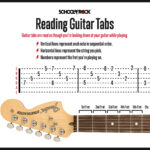Learning guitar chords is a foundational step for any aspiring guitar player. Chords allow you to play along to your favorite songs, create rhythm, and even start songwriting. To navigate the world of guitar chords, understanding guitar chord charts is essential. These charts are a simple yet powerful visual language that unlocks a vast library of chords and musical possibilities on the guitar.
Even before mastering complex solos or fingerpicking patterns, learning to read guitar chord charts will enable you to strum along with countless songs. Whether you dream of singing while playing rhythm guitar or jamming with friends, chord charts are your roadmap.
One of the initial steps in building a comprehensive guitar chord vocabulary is learning how to decipher guitar chord charts. This skill provides you with a shorthand method to quickly learn and play various chords across the guitar neck. This article will guide you through the process of reading chord charts, making it easier for you to learn and play a wide range of guitar chords.
What is a Guitar Chord Chart?
A guitar chord chart is essentially a diagram that provides a visual representation of the guitar fretboard, simplifying how to play a specific chord. It’s a grid made up of vertical and horizontal lines. The vertical lines represent the six strings of your guitar, while the horizontal lines symbolize the frets. At the top of the chart, you’ll typically see a thick black line, which represents the nut of the guitar. This acts as your visual reference point to identify the correct frets for finger placement.
Essentially, a guitar chord chart translates the complex finger positions on a guitar into an easy-to-read diagram, making learning new chords much more accessible for beginners and experienced players alike.
Breaking Down the Parts of a Guitar Chord Chart
While a guitar chord chart visually guides you on finger placement for various guitar chords, understanding its components is key to truly mastering chord reading. The vertical and horizontal lines on the chart correspond to specific elements of the guitar that are crucial for forming chords.
Vertical and Horizontal Lines: Strings and Frets
The vertical lines in a guitar chord chart represent the six guitar strings. They are always ordered from thickest (lowest pitch) to thinnest (highest pitch), reading from left to right in most charts. Here’s a breakdown of each string:
- 6th String (Lowest Tone): Low E
- 5th String: A
- 4th String: D
- 3rd String: G
- 2nd String: B
- 1st String (Highest Tone): High E
Conversely, the horizontal lines in a guitar chord chart depict the frets on the guitar neck. Each horizontal line indicates a specific fret. As you move down the chart, you are moving towards the guitar body and higher-numbered frets. These lines show you exactly which fret on each string needs to be pressed down to play the intended chord.
Numbers and Dots: Finger Placement Guide
Within the grid of a guitar chord chart, you’ll notice dots placed at the intersections of vertical and horizontal lines. These dots indicate where you need to place your fingers on the fretboard. Sometimes, you’ll find numbers inside these dots. These numbers are a guide to which finger of your fretting hand should be used to press down on that specific string and fret.
The numbers are standardized to represent your fingers as follows:
- 1: Index Finger
- 2: Middle Finger
- 3: Ring Finger
- 4: Pinky Finger
If there is no number inside the dot, it generally implies you can use whichever finger is most comfortable or efficient for the chord shape. However, numbered dots are helpful for beginners to learn proper finger placement from the start.
X’s and O’s: Strumming Indicators
Above the thick black line (nut) at the top of a guitar chord chart, you might encounter “X”s and “O”s. These aren’t random symbols; they provide crucial information about which strings to play and which to avoid when strumming the chord.
-
“X”: An “X” above a string indicates that this string should be muted or not played when strumming the chord. Typically, you achieve this by lightly touching the string with a fretting finger or your strumming hand to prevent it from ringing out.
-
“O”: An “O” above a string signifies that this string should be played “open,” meaning you strum the string without pressing down on any fret. The open string is played at its natural pitch.
These “X”s and “O”s are essential for ensuring you play only the correct notes of the chord and achieve the desired sound.
Put Your Chord Chart Knowledge to Practice with Fender Play
Now that you understand how to read guitar chord charts, you’re ready to start playing a vast array of chords and songs! To effectively utilize your new skill, consider exploring resources like Fender Play’s free trial. Fender Play offers a structured and engaging way to learn guitar, incorporating chord charts into interactive lessons and song tutorials.
Fender Play provides an extensive chord library filled with guitar chord charts and lessons designed to teach you how to play a wide variety of chords accurately. You can learn at your own pace, focusing on the chords needed for your favorite songs.
Feeling confident in your chord skills? Challenge yourself with Fender Play’s Chord Challenge mode. This feature allows you to test your ability to transition smoothly between common chord progressions, helping you improve your timing and chord changes – crucial skills for playing with others and mastering songs.
Start your guitar journey today and unlock the world of music with the power of guitar chord charts and resources like Fender Play.


